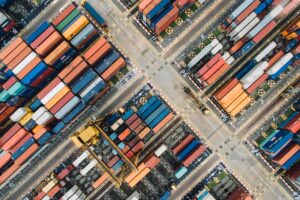Blockchain for Responsible Sourcing – Where Does It Fit?
This blog post discusses the role of blockchain in responsible sourcing. Learn how blockchain can help you make your supply chain more transparent and sustainable.
Blockchain is a revolutionary technology — without a doubt. The next-level security, transparency, and efficiency of blockchain technology will redefine many industries and business processes, especially those dealing with transactional data. It’s no surprise, then, that blockchain has created a buzz in the supply chain management industry. Does the vast potential of this promising technology mean that companies of all sizes and stages should be rebuilding their responsible sourcing systems from the ground up to include it? Or is blockchain still an experiment relegated mainly to the process of tracking products from the source through known supply chains, without much to offer companies looking to comprehensively evaluate environmental and social risks within the supply chain? At Sphera, we’re excited about a future where fully transparent and sustainable supply chains are a reality for every global business. Here we examine the role that blockchain will likely play in furthering transparency and responsibility goals and evaluate current applicability for companies that are developing responsible sourcing programs.
How Blockchain Works
Before we jump into the reasons why we believe it is somewhat premature to consider blockchain as a singular responsible sourcing solution, let’s run through a quick primer on how the insurgent technology works and what it does uniquely well. Blockchain first gained prominence as the platform that powers the cryptocurrency Bitcoin. It functions as a shared electronic ledger upon which transactions are recorded and visible to all users. Unlike an Excel spreadsheet stored on an individual computer or on a cloud-based server, the blockchain ledger is distributed across thousands of computers in a worldwide network, which provides an element of trust for users that the information is authentic. Starting at the source, the shared structure of the blockchain ensures that once a transaction is time-stamped and recorded as an individual “block” on the network, it can’t be altered or hacked by any single entity. Not only does the blockchain offer data security, but also unprecedented transparency. Anyone with permission to access the network can see and track all transactions on the blockchain.
Why All the Buzz About Blockchain for Supply Chains?
Modern supply chains are incredibly complex and global in reach. A single product on a retail shelf may be sourced from thousands of inputs coming out of dozens of countries. For companies committed to selling products that are responsibly sourced and humanely produced, a multi-tiered supply chain is a major challenge to navigate. Such commitments require robust technological solutions that enable supplier discovery, as well as data collection, at multiple tiers across many categories of data. In theory, blockchain technology has the potential to bring new levels of integrity and reliability to globe-spanning supply chains. The ownership of an individual asset or process is verified by the network and visible to all. Contracts are programmed into transactions and are therefore unchangeable and automatically enforced. Once a product is certified as legitimate and authentic, that certification travels with it from the source to the store. So, the idea behind blockchain for supply chains is one of an unbreakable and indisputable chain of custody from source to shelf. In a world where consumers and government regulators are increasingly calling for greater transparency of where and how a product was sourced, how it was made, and how it will be disposed or reused, new technologies are an absolute necessity. However, it remains to be seen if blockchain really is the silver bullet the industry is looking for.
The Blockchain in Action — Walmart’s Mangoes
For a clear example of how blockchain technology can bring value to supply chain management, we can examine the project Walmart launched with its sliced mangoes. A few years ago, Frank Yiannas, a former food safety executive at Walmart, grabbed a package of sliced fresh mango from a Walmart shelf and gave his team a challenge: how fast could they determine exactly where those mangoes were grown and processed? They got the answer, but it took them six days, 18 hours and 26 minutes. Imagine if someone got sick from those mangoes and the company had to figure out what went wrong and where? They’d have to pull all mango products from their shelves until the source of the problem was finally located halfway around the world and nearly a full week later. Walmart launched a pilot program with IBM to record sourcing and supply chain data on the blockchain. Every mango would be stamped with a lot number that would follow it throughout its journey from the mango farm in Mexico to the prepared food display. With the blockchain tracking system in place, Yiannas grabbed another package of mangoes, typed in its six-digit lot number and clicked enter. Seconds later, he had his answer. The mangoes were the Tommy variety, harvested on April 24 on a specific farm in Oaxaca, Mexico, treated for invasive insects, imported to the U.S. on April 27, sliced in a processing facility on May 1, and so forth until the packaged mangoes arrived on the Walmart shelf. Walmart was so impressed with the traceability it gained with its blockchain pilot programs — it conducted an earlier one with Chinese pork — that it has partnered with a coalition of large food producers and retailers (Unilever, Dole, Kroger, and more) to continue working with IBM on an industry-wide blockchain-based tracking system. The diamond industry, led by De Beers, has launched a similar consortium to explore how blockchain certifications and tracking can help eliminate conflict diamonds and forgery from the industry. Blockchain has demonstrated its ability to support traceability efforts in supply chains and may continue to evolve beyond single category projects.
Why Blockchain Isn’t a Silver Bullet for Responsible Sourcing
Clearly, blockchain has great potential for tracking products from the initial source through known supply chains to consumers. However, for the vast majority of responsible sourcing initiatives, it’s likely that blockchain will be able to offer tracking support, but won’t help you answer the bigger question — what’s going on in my supply chain, and how can I use that information to make better decisions for my business? Here’s why: You’re Just Getting Started
You may have caught a key factor of Walmart’s blockchain story: they applied a lot number to the mangoes at the farm level. Why is that important? It means Walmart had already identified those suppliers before they deployed the blockchain experiment. That would present a challenge for most responsible supply chain programs, which are still in the process of identifying suppliers beyond the first tier in the first place. A recent Deloitte survey of Chief Procurement Officers discovered that only 6% of CPOs feel that they have a good understanding of their whole supply chain, so most companies are currently at this stage of the process. If you are new to responsible sourcing and you’re embarking on a company-wide supply chain sustainability effort, then it’s probably too early for a blockchain-based solution. Your first step — and it’s no small one — is to identify and map the dozens or hundreds (or thousands) of individual suppliers, growers, producers, exporters and more who make up your global supply chain. Supply chain mapping is a requirement for any responsible sourcing program and requires tools that are deployed before blockchain tracking can be implemented.
Managing from the Top Down
Blockchain works from the bottom of the supply chain up to the finished product, tracking each component or asset. While verifying the source of a component is important, what’s critical to ensuring a responsible supply chain is the ability to manage from the top down. Assessing the environmental and social business practices of your suppliers, starting with your direct suppliers and then cascading down your supply chain, allows you to map out your supply chain while minimizing supplier risk. Sophisticated, cloud-based supply chain management platforms already exist, and they can give you visibility across every tier of your supply chain. These systems enable you to digitally verify the origins, business practices, and specific processes for every asset in the supply chain, regardless of the topic, with a high level of security. In many cases, the kinds of questions our customers are asking are not designed for storing on blockchain ledgers, so we believe that a hybrid blockchain-traditional tool approach will likely be the optimal solution in the future. Combining transactional product level data with company-wide goal setting and collaboration with suppliers at all tiers of the supply chain will drive responsible sourcing programs forward. Elements of trust that are inherent to blockchain technology will help brands tell the story of their products to their customers. However, in the near future, most organizations will continue to deploy proven responsible sourcing platforms to address their unique environmental and social issues within their supply chain, while IT departments experiment to find ways blockchain could fit into the broader supply chain management space. At Sphera, we are closely tracking the development of blockchain-based applications that help companies monitor and improve their supply chain traceability. We expect to leverage blockchain technology and are examining the most optimal ways that blockchain technology can be integrated into responsible sourcing platforms to further the capabilities of Sphera in delivering full supply chain visibility and sustainability.
SupplyShift was acquired by Sphera in January 2024. This content originally appeared on the SupplyShift website and was slightly modified for sphera.com.






